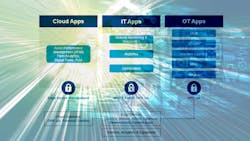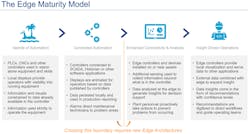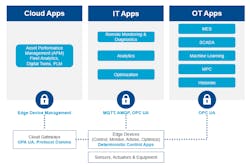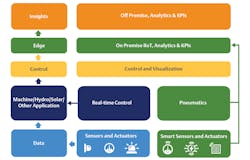At A Glance:
- Improving connectivity within production lines also improves analytics and data management.
- Collected automation provides basic coordinated control at a production line level.
- An edge controller connects various isolated cells on a manufacturing line.
- Edge control hardware and software architectures are key enablers for digital transformation.
Most manufacturing operations are fashioned from many subsystems coordinated into greater production lines. Automating all these pieces located at the industrial edge and orchestrating them to work together smoothly is the initial challenge, and no small task itself.
But once everything is running, the ability to understand how each system contributes to—or undermines—the efficiency of the whole can be even more difficult. Many businesses and factories don’t have a good way of determining their overall equipment effectiveness (OEE) or best operating conditions because they lack the data and visibility to understand how systems are performing and how they can be improved.
As operational facilities recognize this need for data, there are compelling reasons to improve the connectivity within production lines and incorporate the ability for running analytics software applications and supporting innovative services. The right edge technologies enable users to embark on the digital transformation journey, advancing beyond basic line control to implement insight-driven operations.
Programmable logic controllers (PLCs) have been the typical go-to technology for supervisory production line control, and they can be a first step in concentrating available data. But digital transformation demands more. Today, newer industrial automation technologies such as edge controllers can perform real-time deterministic tasks like PLCs, but they are more capable because they include general-purpose computing. Modern edge computing platforms are the key to progressing production line intelligence to higher levels.
Beyond Basic Production Line Control
The edge maturity model describes four stages in the digital transformation of industrial operations (Fig. 1).
Typical manufacturing production lines consist of many islands of automation—equipment for material handling, assembly, packaging and more—which work well in a very localized sense but may not communicate much or at all with each other for better holistic visibility. Operators lack clarity into how all the pieces relate.
Basic coordinated control at a production line level, sometimes called connected automation, is a better solution and is often the reality for more sophisticated sites. At this stage operators can discover how and why things happened, but usually after the fact.
Moving beyond these stages to accomplish enhanced connectivity thorough analysis and insight-driven operations yields many benefits:
- Accessing more data sources
- Performing high-fidelity, low-latency analysis at the edge
- Concentrating results for higher-level systems
- Creating a foundation for developing insights
- Enabling local, remote and web visualization
- Providing remote connectivity access
- Informing the control platform of optimal parameters
Enhanced connectivity not only provides decision-making information but can yield predictive results so plant personnel can work proactively. At this stage operators can discover not only where it happened but, more importantly, where else it can happen and when. Taken to the highest level of the edge maturity model, operational insights can be developed and fed back into the automation for true adaptive functionality. In this mode, the production line runs autonomously by self-adapting to become more efficient and productive. Only the true exceptions are handled by experts.
But moving to these next levels, creating a truly integrated production line, requires more than traditional automation elements and involves crossing a boundary which is only made possible by new edge-enabled automation architectures.
Merging Operations and Information at the Edge
Low-latency data acquired and analyzed at the edge provides responsive results, building a foundation for developing insights. Existing data sources are vital, but additional sensors may be necessary.
Some data—such as energy, environmental and other equipment monitoring signals—originates outside of the normal automation platforms and plant floor sources, but helps operations form a more complete picture. Other relevant runtime and reliability data can only be sourced from manufacturing execution system and enterprise resource planning (ERP) applications running on corporate computing platforms.
A modern hardware and software architecture is needed to blend traditional operational technology with information technology data sources and functions, and to make newer smart sensors accessible, in support of truly insight-driven line control.
The need for seamless connectivity and computation is why standard PLCs are not enough for next-level automation. Once all the necessary data is accessed, intermediate calculations and processing at the edge are necessary to transform raw operational data into useful information. Operators need visibility into the results, and this information is also valuable for higher-level systems. Edge computing offers a way to accomplish this (Fig. 2).
An edge controller is the ideal way to connect various isolated cells on a manufacturing line for enhanced connectivity and insight driven operations. As an evolution of PLCs, edge controllers can still provide the same real-time deterministic control if needed. However, they also incorporate a general-purpose and secure Linux computing environment and IT-friendly protocols, so they satisfy the connectivity and computational needs of advanced control.
Edge controllers can connect to all sorts of data sources—traditional sensors connected via standard PLCs, and also newer smart sensors which can be directly accessed even outside the control architecture. Edge controllers offer a more holistic view of the entire production line, acting as a basic data concentrator, pre-processing the low-latency data into useful information, and providing rich local and remote visualization and access along with analytics for smart line operations resulting in improved OEE (Fig. 3).
When an edge controller is used for line control, predictive algorithms can be continuously applied without impacting the underlying functionality of the production line itself. Production line equipment remains directly under real-time control, which rarely gets updated due to heavy requirements and OT approvals around application logic changes, and even firmware updates.
However, OEE computations and optimization algorithms running on the Linux general-computing portion of the edge controller are easily updated because even if the algorithm is not perfect, it does not stop any production equipment. In the worst case, the line continues to operate but in an unoptimized manner. Users can easily iterate optimizations and build on their successes.
Therefore, edge control hardware and software architectures are the key enabler for a digital transformation from isolated islands of automation to far more advanced insight-driven operations. Performance optimization is not simply on a per-machine or per-function basis but can be extended to an entire production line when the proper edge computing oversight. The ultimate step is reaching a fully adaptive plant, where the system can continuously self-adjust, with exception conditions handled by remote experts.
Tying it Together
The norm for today’s manufacturing production lines is using standard automation to reach a level of reliable production. Improving beyond that level had traditionally been a challenge due to the limitations of available technology.
Edge control provides access to real time OEE and information visualization that changes the value calculation. With edge control, end-users can easily tie together existing equipment, other legacy controllers and new external sensing. The combined raw data can be analyzed at the edge to generate information needed by operators to take fast informed action, and it is the foundation for more advanced production line integration, with the ultimate goal of insight-driven and adaptive operation.
Vibhoosh Gupta is a portfolio leader for Emerson’s machine automation solutions business unit and manages its portfolio of automation system, operator interface, industrial PC, and Industrial IoT software and hardware products for industrial automation.
About the Author
Vibhoosh Gupta
Portfolio Leader, Machine Automation Solutions, Emerson
Vibhoosh Gupta is a portfolio leader for Emerson’s machine automation solutions business unit and manages its portfolio of automation system, operator interface, industrial PC, and Industrial IoT software and hardware products for industrial automation.



